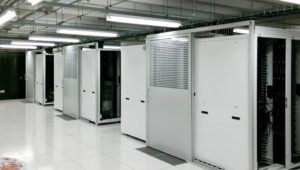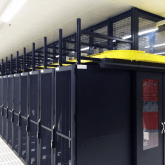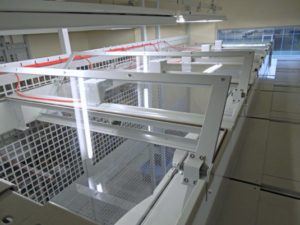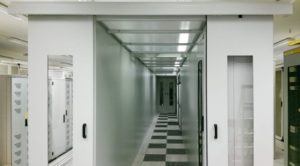Airflow Management vs Thermal Management
In the world of data centres, when it comes to energy efficiency, cost reduction, and equipment life, airflow management and thermal management are thought to be the most popular and effective solutions. Here we take a look at both of them independently, the systems and methods used to implement each, their differences and benefits, and how they can be used together to obtain the most effective results.

Airflow Management
Airflow management controls airflow by directing and blocking conditioned and exhaust air, and managing the volumetric flow rate. Airflow management improves or maintains the intake air temperatures to IT equipment so that the flow rate of conditioned air can be reduced as much as possible, and reduces the highest intake air temperatures so that all intake temperatures are as low and even as possible. This enables changing the control of thermal management, to improve efficiency and increase capacity.
Cold aisle containment is an airflow management system that restricts the loss of cold air, and prevents the mixing of cold air with hot exhaust air, optimising data centre efficiency. A cold aisle containment system is set up by lining up the server and network cabinets in alternating rows, with cold air intakes and hot air exhausts facing opposite directions. Benefits of cold aisle containment include reduced hot spots, improved power usage effectiveness (PUE), extended IT equipment life, reduced carbon footprint and lower emissions, reduced hot spots, and favourable return on investment (ROI).
is an airflow management system that restricts the loss of cold air, and prevents the mixing of cold air with hot exhaust air, optimising data centre efficiency. A cold aisle containment system is set up by lining up the server and network cabinets in alternating rows, with cold air intakes and hot air exhausts facing opposite directions. Benefits of cold aisle containment include reduced hot spots, improved power usage effectiveness (PUE), extended IT equipment life, reduced carbon footprint and lower emissions, reduced hot spots, and favourable return on investment (ROI).
 Hot aisle containment is an airflow management system that ensures that hot exhaust air from the racks is contained within the aisle, enabling the rest of the data centre to become a large reservoir of cold air. Hot aisle containment creates a separate pathway for exhaust air back to the ACU intake, without mixing with cold air; the hot air is ducted away, either via a plenum space in the ceiling, or using large ducts connected to the computer room air handler (CRAH) unit.
Hot aisle containment is an airflow management system that ensures that hot exhaust air from the racks is contained within the aisle, enabling the rest of the data centre to become a large reservoir of cold air. Hot aisle containment creates a separate pathway for exhaust air back to the ACU intake, without mixing with cold air; the hot air is ducted away, either via a plenum space in the ceiling, or using large ducts connected to the computer room air handler (CRAH) unit.
A popular alternative to this approach is in-row cooling, where computer room air conditioning (CRAC) units are built into the cabinet rows. The hot aisle will then typically have a flat aisle roof, and there is no requirement for a hot air plenum. This provides a more granular cooling, as in-row CRAC fan speeds are controlled individually.
Thermal Management
 Thermal management controls the temperature in order to achieve optimum temperature, usually through cooling, as equipment generally generates excess heat. Thermal management maximises rack population and IT footprint, improves the reliability of equipment, and prevents premature failure.
Thermal management controls the temperature in order to achieve optimum temperature, usually through cooling, as equipment generally generates excess heat. Thermal management maximises rack population and IT footprint, improves the reliability of equipment, and prevents premature failure.
The passive approach to thermal management enhances and utilises natural airflow by installing vent openings in the top and bottom sections of an enclosure, and having the hotter equipment lower in the rack, as hot air rises. Passive thermal management is used to prevent hot and cold air from mixing, isolate and redirect the flow of air from side-vented equipment, and open airflow to equipment, and provides cooling without the need for additional fans.
The active approach to thermal management uses forced air through fans to achieve optimum temperature. Thermal management is used when the equipment located within the enclosure produces too much heat for the passive approach to provide sufficient ventilation. Successful active thermal management requires the use of top-mount fans, and no venting in the upper racks or towards the top of the enclosure.
Conclusion
 Although airflow management and thermal management can be used independently, they produce the best results when used in conjunction with each other. Thermal management maximises the benefits of airflow management, so the best practice is to implement an airflow management system first, followed by thermal management. These improvements will reduce operating costs, and increase the capacity and efficiency of the cooling units.
Although airflow management and thermal management can be used independently, they produce the best results when used in conjunction with each other. Thermal management maximises the benefits of airflow management, so the best practice is to implement an airflow management system first, followed by thermal management. These improvements will reduce operating costs, and increase the capacity and efficiency of the cooling units.
With over 15 years’ experience in the design, manufacture and installation of physical IT security solutions to data centres worldwide, Cross-Guard offers a number of bespoke hot and cold aisle containment systems. Our aisle containment systems are highly versatile products that can be easily modified to suit changing requirements.
 Cross-Guard’s aisle containment systems offer combined solutions to the often-conflicting requirements for energy saving, security, and fire safety, with optimum data centre efficiency. The solutions are built to last, can be retrofitted to any type of cabinets, and represent an excellent return on investment.
Cross-Guard’s aisle containment systems offer combined solutions to the often-conflicting requirements for energy saving, security, and fire safety, with optimum data centre efficiency. The solutions are built to last, can be retrofitted to any type of cabinets, and represent an excellent return on investment.
For more information on airflow management, achieving data centre efficiency, or Cross-Guard’s solutions, please visit our blog for case studies and reports, or contact us via sales@cross-guard.com or 01724 271999 to speak to a member of our expert sales team.
SHARE
DOWNLOAD A COPY OF OUR BROCHURE

